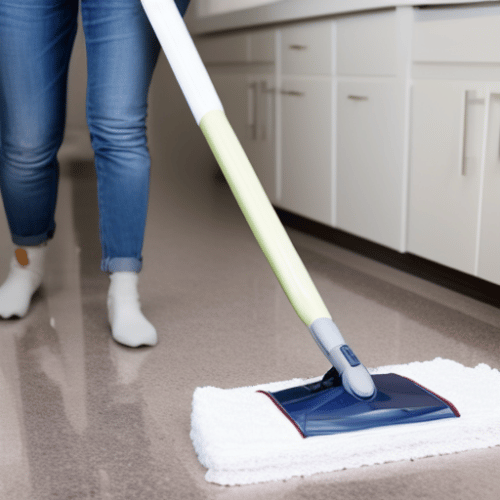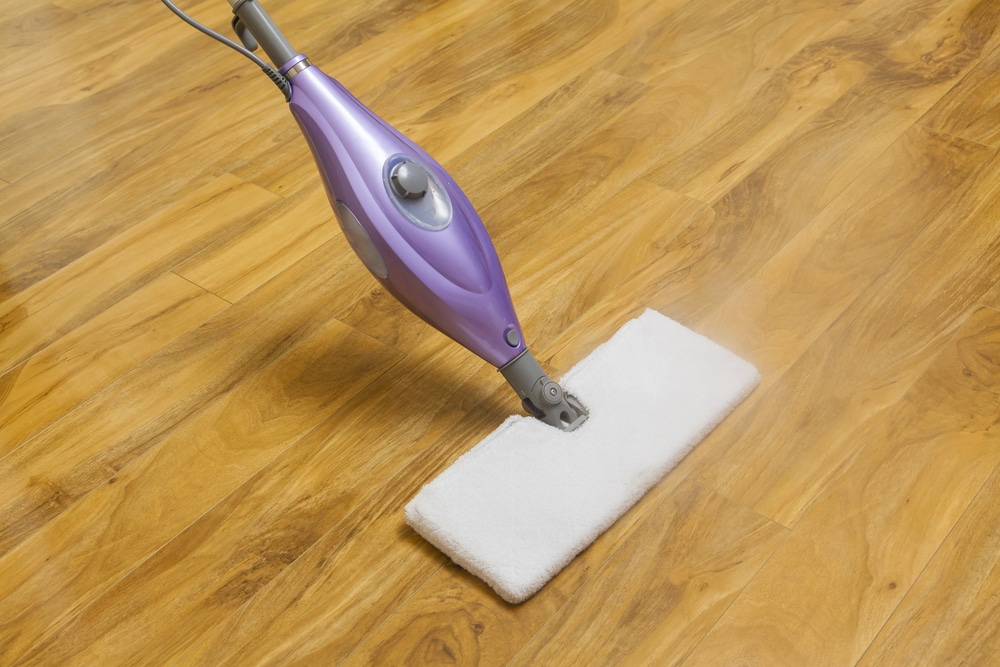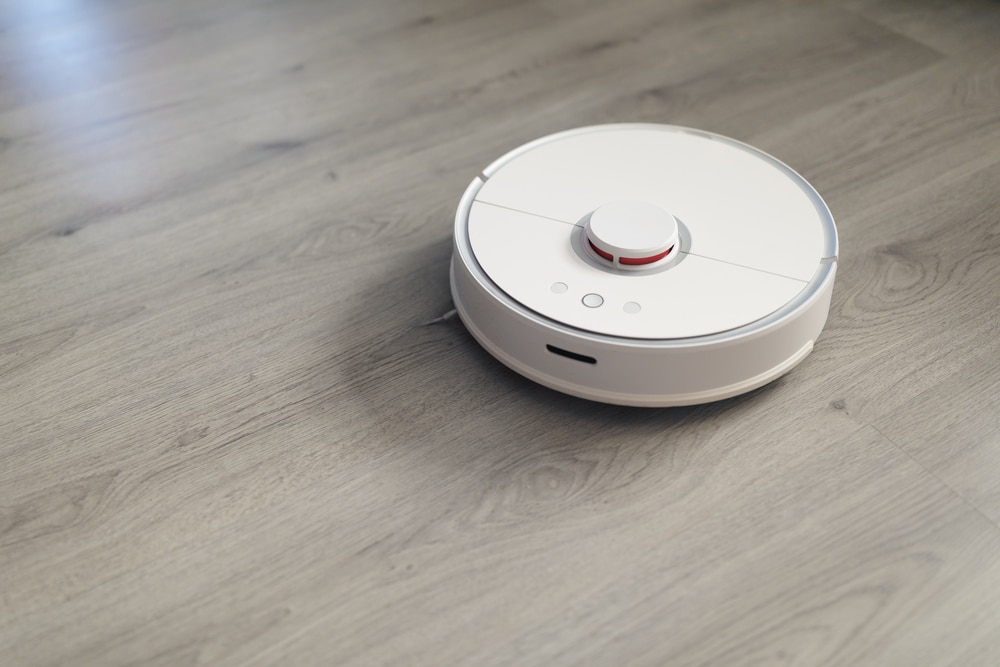Last Updated on
Steam mops are great for cleaning and keeping sealed hard floors hygienic. But, they can easily become clogged if they get a lot of use or are not cleaned somewhat regularly. Additionally, a clogged spray tip could be the issue if your steam mop stops functioning as it should or fails to produce steam when you turn it on.
Fortunately, there is an easy fix for this issue. This article will teach you how to unblock a steam mop and offer some helpful tips to help keep your steam mop working in peak condition for as long as possible.
Getting Started: Steam Mop Basics Explained
What Causes Buildup in Your Steam Mop?
Even the most well-known and effective steam cleaners, such as the Shark steam mop, can develop a blocked nozzle with ease. This is one of the most common complaints about shark steam mops and other steam mops alike. So, what causes this, and aside from regular cleanings, how can you help prevent it from happening?
With extended use, mineral deposits in your water can easily build up inside your water tank and on the spray nozzle. If you use your steam mop to steam a carpet, it is a good idea to check if it needs cleaning, even if you have cleaned it recently. This is because carpets can become really dirty and they require a lot of cleaning.
In addition, calcium and other minerals are often present in tap water, even if you don’t have hard water, which has a high mineral concentration. To help prevent further limescale buildup, most manufacturers recommend using distilled water in their steam mops.
Don’t use dryer sheets or fabric softeners when you wash the mop head cleaning pads. The chemicals in these products can stick to the material, make them less absorbent, and stick to the spray nozzle, leading to blockage.
Always make sure to empty the tank after every use. If you leave the water to sit in the tank of your steam cleaner, it will cause buildup to accrue faster.
Before You Begin: Cleaning Prep
To unblock your steam mop, you will need to gather a few supplies. Chances are you already have what you need in your home to get the job done, but they shouldn’t be difficult to acquire, even if you don’t.
What You’ll Need:
- White vinegar (can also use baking soda and water or a professional decalcifying cleaning product, but vinegar is our favourite cleaning agent)
- Distilled water (tap water will work, but it is best to avoid hard water while cleaning)
- Large paper clip or a descaling pin
- Cotton swabs
- Clean cloth
- Screwdriver, depending on your specific device
Unblock Your Steam Mop: A Step-by-Step Guide
Step 1: Unplug Your Mop and Let It Cool
Start by unplugging your steam mop and giving it time to cool down. If you are looking to unblock your steam mop, chances are pretty good. If you tried to use it and discovered it was not producing steam, it means that you will need to let the device and water container lose most of its heat before you fix it.
Step 2: Empty the Water Tank and Add Vinegar
Once the water in the tank reaches the right temperature, empty the water reservoir. Then refill it using equal parts white vinegar and distilled water. This will help break up minerals and loosen debris. Allow the solution to sit overnight.
Some people like to use a mixture of baking soda and water instead of vinegar because the odour isn’t as harsh. However, both options work about the same as far as unblocking any clogged parts, so you may want to experiment with both options or try the one that is readily available to you.
You can use tap water instead of distilled water, but due to the high prevalence of hard water, it is best not to add more minerals while trying to get rid of them.
Pro-Tip: If you don’t want to purchase distilled water, you can also boil your tap water and let it cool to achieve a similar effect.
Step 3: Produce Steam With the Vinegar
After you let your steam mop’s tank soak, plug it in, turn it on, and give it time to get hot. Once it builds up enough steam, pull the trigger and allow the device to spray with the vinegar in the tank. As the steam shoots out, it should help clear out a blocked nozzle while also removing any other buildup inside. Let your mop produce steam until the tank is once again empty.
Vinegar is a highly effective cleaner, so it may be tempting to steam your floors while unblocking. However, we strongly advise against this. The vinegar inside will most likely be full of dirt, grime, and mineral deposits, so it is best not to put this on your floors.
Step 4: Refill With Clean Water and Produce Steam

Refill the tank with clean distilled water and turn it on. Give it some time to become fully heated, and then press the trigger to make more steam. Just like with the vinegar, steam all the water until you are left with an empty steam mop once again.
This step helps to rinse out the interior of the steam cleaning mop and ensures any interior buildup is completely unstuck. At this point, your steam mop should be unblocked, making plenty of steam and ready to start cleaning again. This means the next couple of steps is not required, but they can help prolong the time between cleanings.
Step 5: Descale the Spray Tip
Follow these steps when descaling the spray tip:
- Before you descale the spray tip, you will want to unplug your steam mop for safety reasons.
- Double-check the spray nozzle and look for any visible buildup and debris.
- Then, using either your descaling pin or a large paper clip, insert the end into the spray tip and move it in circles to loosen any leftover buildup around the edges of the hole.
- Finally, use a cotton swab dipped in vinegar to clean around the edges of the spray nozzle.
Depending on your specific steam mop machine, you may need to unscrew the base to access the spray tip. If so, it typically only has one screw, but you should refer to your mop’s user manual for specifics.
Step 6: Clean the Mop Head
For the final step, dampen a clean cloth with a bit of vinegar and wipe off the entire mop head. After this, your steam mop should be restored to its original steam cleaning power. After you let the mop air dry, it will be ready for use like normal.
Other Things to Consider
Here are some other helpful things that can help you in taking care of your steam mop.
How Often Should You Clean Your Steam Mop?
In order to prevent future blockages from occurring, your best bet is to clean your steam mop once every six weeks. A small amount of preventative maintenance will help your steam mop work to the best of its ability for years to come. Most manufacturers also recommend you mop regularly to prevent dirt on the floor from being picked up where it can fill the spray nozzle hole.
Also, if you notice your machine is not steaming like normal, you should probably try cleaning it, regardless of when the last cleaning was.
Pro-Tip: If you are short on time, you can descale the spray nozzle and wipe the mop head to achieve noticeable results without having to clean the tank as well.
What if My Steam Mop Still Doesn’t Work?
If your steam mop still is not working after you clean it, several other things could be contributing to its inability to produce steam. Troubleshoot the following things before you decide it is either time to throw away your steam mop or possibly take it to a professional for repair.
- This may seem a bit obvious, but first, you will want to make sure your steam mop is plugged into mains power and turned on. If you are in a hurry, it is possible you overlooked this step accidentally, or the cord could have been knocked out of the mains socket by a pet or pulled on too much.
- Next, make sure the water tank is full. If there is not enough water, your steam mop may be unable to make steam. Fill the tank to the fill line every time you use it to avoid this issue, even if you are only steam cleaning a small amount of floor space.
- Just like with a typical steam cleaner, a lack of pressure in the tank or a pressure leakage can also lead to your steam mop malfunctioning. Check that the cap for the water tank is securely closed so pressure can build up inside.
- You also need to make sure you chose the correct setting on your mop with the max steam output. It is possible you tuned down the steam level to a lower setting.
- Another common mistake is not waiting until the water is heated up all of the ways. The water has to be very hot for the mop to make steam. If you try using it prematurely, it will not work as a steam cleaner.
Caring for Your Device Made Easy
Now that you know how easy it is to descale and unblock your steam mop, we recommend you undergo the cleaning process somewhat regularly to prevent clogs from occurring in the first place. After you try it out a couple of times, the process should become second nature.
Let us know what you think in the comments below, and good luck!
Emily is a woman of many talents. She has a B.A. in English and enjoys writing. Emily loves accessorising her home with quality products that not only serve a purpose but also enhance the overall convenience and tranquillity of her living space; there’s nothing like coming home to your own personal sanctuary after a long day! She loves anything that can make life easier or more comfortable—from dishware to furniture to lighting fixtures.



